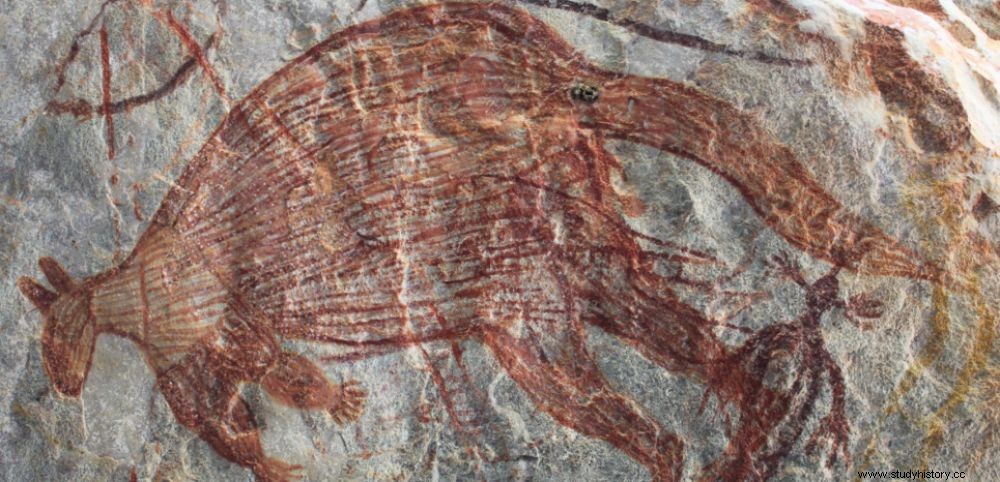 Cave paintings in the Kimberley region of northern Australia are believed to be among the oldest in world.
Cave paintings in the Kimberley region of northern Australia are believed to be among the oldest in world. AUSTRALIA. For thousands of years, people have decorated the walls of rock shelters in the Kimberley region of northern Australia with an extraordinary profusion of cave paintings. Myriads of works representing animals, symbolic images or creatures with human forms. Knowing precisely the age of these creations, that is to say the moment when they were fixed on the rock, constitutes one of the major challenges for specialists in prehistoric art. It remains indeed always difficult to directly date the pigments of the figures mainly executed in ocher (mineral). The preferred method for absolute dating remains that of carbon 14, and can only be applied to samples containing organic matter (such as charcoal), which limits the possibilities.
 Mason wasp nest on rock painting in rock shelter in northern Australia (© Dr. June Ross / Kira Westaway)
Mason wasp nest on rock painting in rock shelter in northern Australia (© Dr. June Ross / Kira Westaway)
But for three years, Dr. June Ross, from the University of New England (Australia), has been experimenting with an original and ingenious device, developed by Maxime Aubert from Griffith University in Brisbane, which could make it possible to overcome this obstacle. in some cases. In an article published in the journal PLos One , the archaeologist at the head of the Australian project explains how she was able to determine ancient dates... thanks to the analysis of wasp nests!
 A mason wasp. © Dr. June Ross / Kira Westaway
A mason wasp. © Dr. June Ross / Kira Westaway
Mason wasps (Sceliphron laetum ) indeed build small cells using mud pellets made up of grains of sand mixed with their secretions. They then deposit these structures on the walls of the rock shelters... and therefore sometimes on the cave paintings. "Once dried, these nests become fossilized and can remain on the walls for thousands of years , says Kira Westaway, geomorphologist at Macquarie University in Sydney, joined by Sciences et Avenir. Dating these fossil muds allows us to estimate the minimum age of their creation and therefore that of the reproductions located below" , she says.
 A 16,000-year-old "Yam" rock figure, thanks to wasp nests! © Dr. June Ross/Kira Westaway
A 16,000-year-old "Yam" rock figure, thanks to wasp nests! © Dr. June Ross/Kira Westaway
We we were thus able to date a "yam" figure to 16,000 years ago. ". To obtain these results, the Australian team used a method called optically stimulated luminescence (OSL) by applying it to the grains of sand collected in the mud of the dwellings of these Hymenoptera. "OSL provides the ability to measure the time elapsed since grains of sand exposed to sunlight became camouflaged in the mud of wasp nests says the archaeologist.
 Digital image of a kangaroo figure belonging to the Wanjina period, in the Kimberley region (© Dr. June Ross/ Kira Westaway)
Digital image of a kangaroo figure belonging to the Wanjina period, in the Kimberley region (© Dr. June Ross/ Kira Westaway)
One more step in confirming the great antiquity of Australian rock art, the oldest effigies of which date back more than 35,000 years. Ages that associated with those of 39,900 years recently obtained in Asia, on the island of Sulawesi, near Borneo, come to challenge European sites such as the Chauvet caves 37,000 years (Ardèche), Lascaux 17,000 years (Dordogne) or Altamira 15,000 years (Cantabria, Spain), long described as the oldest in the world. French prehistorians have been working for several years in Australia to study these Paleolithic frescoes. If Australia's rock heritage is unique because of its diversity and richness, it is also so for another reason. Australia is indeed the only place on the planet where these frescoes still embody a real history book for its indigenous inhabitants. A tangible link with the past and their ancestors. The one from the time of the dream.
